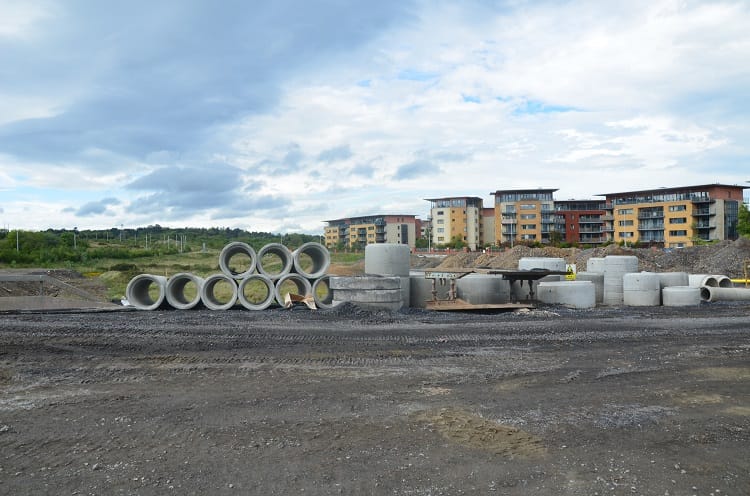What’s the best way to tell area residents about plans for a new asylum shelter nearby?
The government should tell communities directly about plans for new asylum shelters, some activists and politicians say.
A project by developer Hines in Cherrywood, for example, got €15.19 million in funding, meant to encourage affordable housing, for which there is as yet no plan in place.

Last August, Minister Simon Coveney and the Department of Housing announced plans to give out €200 million to pay for essential infrastructure for big building projects, as a way to encourage the construction of more housing.
Part of the pitch was that developers that benefited from the funding were to give back to the public by providing affordable housing on the sites.
But two circulars show that the department watered down what it was asking from developers in exchange for the subsidy.
The government also allocated some of the money to support infrastructure around the Hines-owned Cherrywood site even though – according to a spokesperson for Dún Laoghaire-Rathdown County Council – it has not yet agreed how many affordable units will go there.
Who usually pays for the infrastructure varies depending on where it is.
“Infrastructure required for development within/without the developers’ land holding is usually funded by the developer or as conditioned by a planning permission,” according to a spokesperson from Dublin City Council Press Office.
Infrastructure required outside of their boundary can be funded from various sources: the developer, the local authority, the central government, or the European Union, depending on who benefits, said the spokesperson.
In statements around the €200 million Local Infrastructure Housing Activation Fund (LIHAF), the Department of Housing and Fine Gael Minister Coveney have stressed that it would lead to more affordable housing.
“There is a strong focus on affordability in the projects being funded under LIHAF,” said a statement released in early April.
But there has been little detail about exactly how many affordable homes there will be on the sites that benefit from the fund, which are spread across 15 local authorities.
One of the biggest housing sites to get LIHAF funding for infrastructure was Cherrywood, to the south of the city, where 8,000 new homes are planned. The government allocated €15.19 million for road upgrades and a bridge there.
About 60 percent of the site is owned by the developer Hines, according to its spokesperson Robert Hanley.
But Hanley was unable to say how many of the 8,000 units would be affordable in the development, or to directly answer a series of questions asking how many affordable units there would be and what cost they would be.
“Cherrywood will have 10 percent social housing in line with current requirements,” said Hanley, by email on 10 May.
But social housing and affordable housing are not the same. Social housing is owned by local authorities, while affordable housing might be privately owned, but would be either purchased or rented at a lower cost.
The 10-percent social housing doesn’t satisfy the requirement for affordable housing under LIHAF, according to a Department of Housing Spokesperson Eddie Kiernan.
“The provision of the required 10 percent under Part V will be a factor in evidencing affordability but it must also extend to the rest of any relevant private housing on the site,” said Kiernan.
On 15 May, in response to questions about how many affordable units there would be on the site, a spokesperson for Dún Laoghaire-Rathdown County Council said that “there is currently no affordable housing scheme in operation”.
“All planning applications for Cherrywood will be required to provide social housing units through Part V of the Planning and Development Act,” she said.
That refers to the legal obligation on all developers to build 10 percent social housing in all developments of more than nine units. But does that mean that there is no affordable housing in addition to the normal requirement, despite the extra funding?
After a series of follow-up queries, a spokesperson for Dún Laoghaire-Rathdown County Council sent an email on 16 May, saying that the council is in negotiations with the developer to secure an element of affordable housing at Cherrywood.

It’s unclear why this agreement is not already in place.
On 3 April, Coveney said local authorities “have received commitments from housing developers with regard to affordability”.
We put it to Dún Laoghaire-Rathdown County Council that it was supposed to have already secured a deal on affordability from the developer Hines (a company that says it “has a presence” in 189 cities in 20 countries, and has $96.5 billion in assets under management).
“It is acknowledged that developers’ commitments to deliver affordability is a prerequisite,” said a county council spokesperson on 16 March, by email.
She said: “Discussions are ongoing with the relevant parties and the Housing Delivery Office which will include the preparation of the supporting legal agreements.”
They have already granted planning permission for some parts of the site, said a spokesperson for Dún Laoghaire Rathdown County Council.
Several councillors for Dún Laoghaire-Rathdown said that they hadn’t heard about affordable housing being an option on the Cherrywood site.
Councillor Ossian Smyth of the Green Party said he would like to see an affordable element to the project, but hadn’t heard anything about one.
Labour Councillor Carrie Smyth said her constituents would be really interested if there was to be affordable housing in Cherrywood, but she doubted that it was on the table as she hadn’t heard anything about it.
She expects there to be affordable housing on another site, at Shankill, because that is council-owned, she said.
What the Department of Housing has asked for from developers has been watered down since the department announced the infrastructure fund last August.
At first, a circular from the Housing Department on 26 August said that the funding would be granted to developers in return for a “minimum 40% of homes delivered, to be available at prices at least 10% below the average cost of market housing including under €300,000 in Dublin”.
Just weeks later, on 30 September another circular was issued by the department, scrapping that stipulation and saying it is up to local authorities to negotiate individually to get affordable housing.
A lot more counted towards meeting the affordability requirement, according to the circular: housing through approved housing bodies or social housing through social-housing programmes, and the social housing units that developers already have to give if they are building more than nine homes.
Bids had to include proposals for affordability on the basis of a measurable cost-reduction exercise that compares between a “before” and “after” LIHAF funding scenario, it also said.
This rollback came after feedback from local authorities and housing providers was that it wasn’t possible to meet the requirements that had been set, if you consider average values for similar house types in some of those places and, in particular, in parts of Dublin, the circular said.
It’s unclear who exactly told the department that it wasn’t possible to build that percentage of affordable homes.
A spokesperson for the Department said they held a “LIHAF discussion and briefing forum for local authorities and housing providers in September 2016.”
They discussed at that meeting that considering average house prices in the localities of some sites, it would not always be possible to deliver on the previous commitment, of 40-percent affordable housing, he said.
Another spokesperson for the Department of Housing, John Whelan, said by email: “the Department did not drop the affordability criteria but amended it”.

Architect and property expert Mel Reynolds said that Housing Minister Simon Coveney often talks vaguely about delivering affordable housing.
“The real questions are, how many units will there be, when will it be delivered and how much will they cost?” he says.
Several local authorities in the areas around Dublin said that they are unable to answer those questions.
There were three sites, or groups of sites, in Fingal County Council area that got funding through the LIHAF scheme that totalled €26.6 million. One of the sites is council-owned, according to the project descriptions.
But a Fingal County Council spokesperson said it was unable to give details about the housing types that will go on the lands that benefit.
“The cost of the units would be a matter for the developer,” they said, by email. They also noted that, as with all big developments, the projects would need to comply with Part V requirements for social housing.
A spokesperson for South Dublin County Council said it didn’t have time to pull together the details of units that would be built on the sites that benefited from the fund in its area. Dublin City Council didn’t respond to the same queries.
Some argue that the LIHAF funding won’t achieve its aim of speeding up building by removing obstacles.
Developers can well afford to pay for the infrastructure themselves, says Reynolds, the architect. “The reason they sit on land is because that is more profitable than building on it when prices are going up, like they are at the moment.”
Green Party Councillor Ossian Smyth for Dún Laoghaire-Rathdown County Council says he is afraid of this.
It will cost about €160 million for all the infrastructure costs in Cherrywood, and Dún Laoghaire-Rathdown Council will actually shoulder some of that itself, because they are afraid to charge the developers the whole amount, in case it stops them from building, he says.
“Because there is no site-valuation tax and no levy on developers who obtain planning permission and then don’t use the land, there is no way to force a private landowner to build,” he says.
“You do have to wonder why NAMA and other state-owned institutions allowed large land banks to be sold to private developers and left fallow when the state could have built housing on these sites directly,” says Smyth.
Even if it does get developers building, simply flooding the market with supply will not drive down or even stabilise the price of housing, says Stephen Kinsella, a lecturer in economics at the University of Limerick.
He says that normal rules of supply and demand just don’t apply to housing. “It’s true for oranges, it’s true for barrels of oil and for pencils,” says Kinsella. “But it is not true of housing.”
This is because of the formula developers employ when deciding whether to build, says Kinsella. Unlike with other industries they may be better off not doing anything.
Reynolds says that supply is in fact part of the problem, and he expects prices to jump in the next year.
“The problem is that the government measures to increase supply are working because they are inflating prices, we know from 40 years of data that when supply comes onto stream, about a year after, prices go up,” he says.
Increasing supply will not provide housing, that the average couple can afford, unless there is a definite plan for some of it to be affordable, he says.